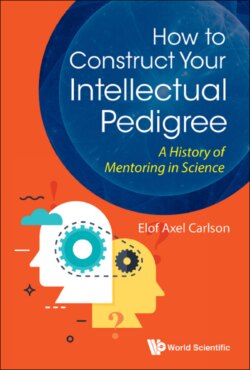Читать книгу How to Construct Your Intellectual Pedigree - Elof Axel Carlson - Страница 16
На сайте Литреса книга снята с продажи.
9My Connection to Muller’s Academic Pedigree
ОглавлениеIn his academic career, Muller served as a mentor to numerous students. Most of these were graduate students, technicians, and students in his classes at Columbia, at Rice University, at the University of Texas, at the Kaiser Wilhelm Institute in Berlin, at the genetic institutes in Moscow and Leningrad when he was in the USSR, at the University of Edinburgh, at Amherst College during WWII, and at Indiana University. Two students who did not go into genetics are of interest. Amelia Earhart took Muller’s course when she was an undergraduate at Barnard College and he was a graduate student. They became friends. She wanted Muller to take flying lessons, but he couldn’t afford them. Carl Sagan spent a summer as an undergraduate working in Muller’s laboratory. He was an undergraduate at the University of Chicago at the time. He hoped to apply his knowledge of genetics to astronomy, especially the hunt for intelligent life in the universe and the chemical stages of evolution leading to life.
Among his students at the graduate level are (in chronological order): B. Glass, W. S. Stone, C. P. Oliver, D. Raffel, A. Prokofeyeva, C. Offerman, I. Agol, J. Kerkis, S. Levitt, R. Berg, G. Pontecorvo, C. Auerbach, A. R. Sidky, S. P. Ray-Choudhury, I. Oster, S. Abrahamson, A. Schalet, S. Iyengar, E. Carlson, W. Ostertag, S. Frye, William Trout III, and D. Wagoner. Like me, all these students and the students they mentored, could attach themselves to the Muller pedigree. Colleagues who were mentored by Muller include E. Altenburg, J. Huxley, J. Patterson, T. Painter, A. Serebrovsky, N. Dubinin, N. N. Medvedev, N. Timofeef-Ressovsky, M. Delbrück, J. D. Watson, and J. Crow. At the same time, colleagues were providing skills and ideas to Muller and the exchanges were often two way. That happens also with graduate students and postdoctoral students where ideas are freely exchanged. Note that at least 35 people can be attached to Muller’s academic pedigree.
While Muller was influential on my life as my primary mentor for genetics, I had a second, earlier, profound mentor when I was in Thomas Jefferson High School in Brooklyn, NY from the Fall of 1947 to the Spring of 1949. I read aloud to Morris Cohen from the classics over a period of five years, meeting him for an hour about 7 a.m. five days a week while school was in session. I attended NYU on a scholarship and majored in biology and minored in history. Mr. Cohen’s influence was in relating science to society and history. It was Mr. Cohen who told me to read Schrödinger’s What is Life? while I was still in high school. I was accepted to Indiana University in Bloomington, Indiana where I studied genetics with Nobelist H. J. Muller. I have had the pleasure of supervising the PhD dissertations of six students (and seeing 13 of my books published). My most noted books are The Gene: A Critical History (1966), Genes, Radiation, and Society: The Life and Work of H. J. Muller (1981), The Unfit: A History of a Bad Idea (2001), and Mendel’s Legacy: The Origins of Classical Genetics (2007). My PhD was on the structure and mutability of the dumpy gene in fruit flies. My laboratory research involved comparative genetics, gene structure, and mosaicism. I applied my work on mosaicism to medical genetics using retinoblastoma as an example. I have published articles on gene structure, chemical mutagenesis, and human genetics. I taught at Queen’s University in Canada (Queen’s University), at UCLA, and at Stony Brook University before retiring with my wife, Nedra, in Bloomington, Indiana. Muller’ concerns about the applications of genetics to society became part of my approach to writing and teaching.
